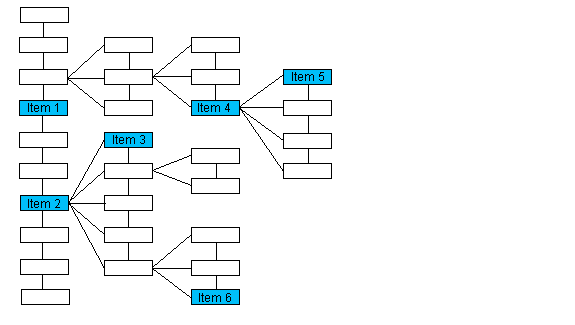←Select platform
In This Topic ▼
GetChild Method
Summary
Returns the item in the IOD Structure that contains the first child of the specified item.
Syntax
C#
C++/CLI
Java
public DicomIod getChild(DicomIod iod)
Parameters
iod
an item in the IOD Structure.
Return Value
DicomIod that contains the item in the IOD Structure that is the first child of the item specified in the IOD.
Remarks
- This method requires that the IOD Structure is evaluated as a tree structure.
- The child is the offspring one level lower than the specified item. If the specified item has no child items, this method will return null. For example
-

If the passed class is : The method returns: Item 1 null Item 2 Item 3 Item 4 Item 5 Item 6 null The following methods will also help you navigate the IOD Structure:
Example
C#
using Leadtools;using Leadtools.Dicom;public void RecursiveReadIOD(DicomIod parentIOD){DicomIod iod;if (parentIOD == null){iod = DicomIodTable.Instance.GetFirst(null, true);}else{iod = DicomIodTable.Instance.GetChild(parentIOD);}while (iod != null){// Over here we can show the information about this IOD such as// DicomIod.Name, DicomIod.Type, DicomIod.Usage and DicomIod.Descriptionif (DicomIodTable.Instance.GetChild(iod) != null){RecursiveReadIOD(iod);}iod = DicomIodTable.Instance.GetNext(iod, true);}}void TestIODTable(){//Make sure to initialize the DICOM engine, this needs to be done only once.DicomEngine.Startup();//We don't need to call this since the DicomEngine.Startup already does that for us//These calls are for demonstration purposes onlyDicomIodTable.Instance.Reset();DicomIodTable.Instance.Default();// We can find the number of modules in any classint moduleCount = DicomIodTable.Instance.GetModuleCount(DicomClassType.SCImageStorage);// We can in here call any of the Find methods including FindModule and FindModuleByIndex,// in this sample we are searching for a DICOM class, this is why we are using FindClassDicomIod iod = DicomIodTable.Instance.FindClass(DicomClassType.SCImageStorage);// We can get the name of the IODstring name = iod.ToString();DicomIodTable.Instance.Delete(iod);DicomIod iod1 = DicomIodTable.Instance.Insert(null, false, DicomClassType.SCImageStorage, "Secondary Capture Image Storage", DicomIodType.Class, DicomIodUsageType.MandatoryModule, "Description of the class goes in here");Debug.Assert(DicomIodTable.Instance.Exists(iod1) == true);DicomIodTable.Instance.SetName(iod1, "Secondary Capture Image Storage 1");//Go through all the IODs in the IOD tableRecursiveReadIOD(null);DicomEngine.Shutdown();}
Requirements
See Also
Reference
Help Version 23.0.2024.8.20
Products | Support | Contact Us | Intellectual Property Notices © 1991-2025 Apryse Sofware Corp. All Rights Reserved.
Leadtools.Dicom Assembly
